2006 Tour Report by Sarah B. Scott
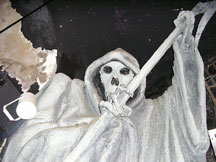
Photos by Bob & Holly King, Shannon Werner, Erin Mullin, Cindy Grant, Lynn Baker, David Dobbs,
Jeffrey Barach, Dr. Robin Woodall, Dennis Kathrein, Marinda Kathrein and Sarah & Justin Scott
Having heard of the wonderful experiences of those who had attended the Ghost Tour before, "excited" was not enough of a word to describe the anticipation. The groups from many different prior tours quickly blended and formed wonderful new friendships. At the airport, our tour host, Charles, gave us all some ghostly goodie bags for our flight and we were on our way.
When we arrived in London we met up with our very proper British guide, Alan Murdie. He was the chairman of The Ghost Club until 2005 and has written several books on hauntings. We boarded a bus that looked like a caterpillar and headed for our first hotel, the Kings Cross Travelodge. All of the hotels were fine, even though they were chain hotels. We stayed in Travelodge and Ibis hotels since our group of ghouls was simply too big for the haunted hotels and inns.
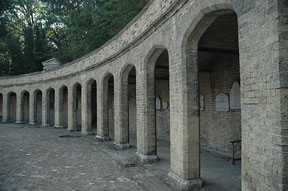
Highgate Cemetery walls
After checking into the hotel, we went to our first tour location, Highgate Cemetery, which is famous for the "Highgate Vampire" from the 1970s. We arrived at about 3:30pm. In the 1970s, Highgate Cemetery was poorly maintained and almost wilderness. It is more tended now than it was, but some parts are still beautifully overgrown. Upon arrival at Highgate, we were divided into two groups and then taken to different sides of the cemetery to begin our tours. Highgate is wonderfully creepy. We were told to answer, if asked, that we were a University group. It seems that they would have been less accommodating if they knew our real interests. Needless to say, there was no discussion of the Vampire, but it was a wonderful visit nonetheless, with the highlight being the "Avenue of The Dead."
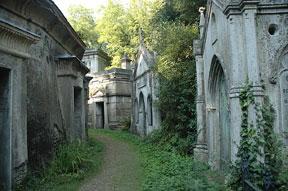
Avenue of the dead
We received a bit of historical information about Highgate at the start of our tour. Highgate was built as one of the "magnificent seven" cemeteries that were meant to relieve the older inner-city cemeteries when London's population was booming. We started with the eastern side, known as the "East Cemetery." In the "East Cemetery," we saw the graves of Karl Marx and Mary Ann Evans, the author known as "George Eliot." Douglas Adams, the author of "Hitchhiker's Guide to the Galaxy," is also buried there.
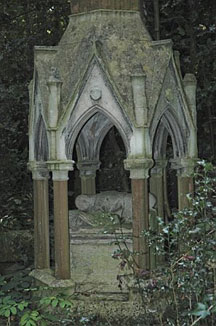
Creepy Highgate
In the "Western" side, we were readily steered away from many of the potentially vampire related sites, but we did receive a good education in Victorian death symbols and practices on the way to the Egyptian Avenue. We learned that many people had symbols of their professions on their graves. Other symbols were broken columns (symbolizing a life cut short), wreaths (immortality), and inverted torches (life extinguished).
The Egyptian Avenue was built at the height of Victorian archeological discovery in Egypt. This area was distinctly colder than the rest of the cemetery, and a few people commented on seeing a misty figure. At the end of the Egyptian Avenue is the Circle of Lebanon, which surrounds the Cedar of Lebanon, an over 300-year-old tree. This area is still beautiful, and it is easy to see why the vaults in these areas were so prized by those who could afford them.
We also saw the mausoleum of Julius Beer. It is one of the largest tombs in Highgate and would cost millions of dollars if it were built now. He was a wealthy man but never accepted into the high society because he was Jewish. He built his mausoleum in front of a promenade typically used by the wealthy, so that they would have to look at it when looking out over the cemetery. The area in front of this mausoleum also was distinctly colder than the rest of the cemetery. Was Mr. Beer giving the cold shoulder to the wealthy people surrounding him even in death?
Many of us kept an eye out for the tomb of the Highgate Vampire but were unable to find it. Needless to say, they would not point it out to us.
Our next destination was the Spaniard's Inn, a haunt of notorious highwayman Dick Turpin in his life and allegedly now also. He has been sighted there many times. Turpin's ghost has also been seen on Hampstead Heath and Epping's Woods. The Spaniard's Inn is mentioned in many works of literature, most notably "Dracula" and the Pickwick Papers.
For our purposes, the Spaniard's Inn was home to wonderful food, and our first group meal of the journey. We were treated to traditional regional food, including a ghoulish ghoulash (actually, green pea and mint soup, which was delicious!). Our tour's first very special guest appeared this evening.
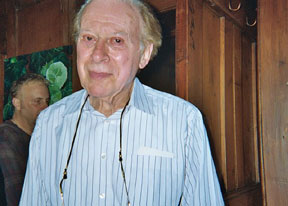
Robert Rietti
We were treated to "Ghostly Coincidences," a special spooky but heartfelt storytelling session by our tour's first special guest, Robert Rietti of the BBC. Sir Rietti was like British royalty to us, and he was too modest to tell us that he did voice-over work for some of the James Bond films. He got a great ovation after his spine-tingling and hair-raising tales, and we all had a dessert of chocolate cake with butter cream sauce to end the meal. We returned, stuffed and exhausted but exhilarated, to the hotel.
We awoke the next day bright and early for our "tube day," and off to visit the London Dungeon, London Bridge, the Tower of London and a West End play in Covent Garden. Our first destination was the London Bridge tube station, and a short walk to the London Dungeon.
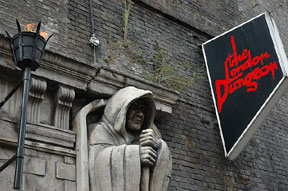
Dungeon Entrance
The London Dungeon is huge, naturally cold, and built into a converted railway arch. It's supposedly haunted, but any ghost would be hard to tell apart from the numerous exhibits of disease, torture, jail and punishment. The most memorable were those of Jack the Ripper's world, and the Great Fire of 1666.
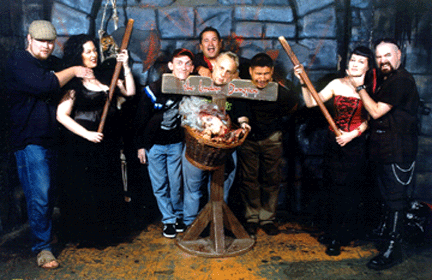
Souvenir Photo At The London Dungeon
There was also an adventure ride, and some interactive rooms with actors. One of our travelers was judged to be a witch (little did he know that there was more than one in our group!) by a corrupt judge, and found guilty.
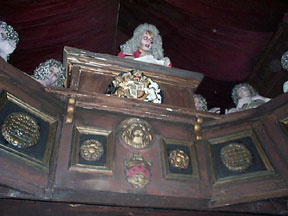
Judged by a Witch hunter
Before we departed, we spent some time, and lots of money, at the "Dungeon Shop of Horrors," which offers some great horror souvenirs and knick-knacks. We discovered what a shop-aholic one of our tour-members was, as we literally had to pull Lynn away from the shopping in here.
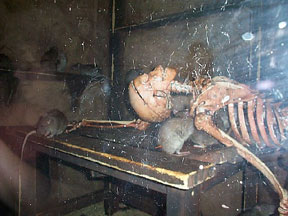
Inside London Dungeon
We truly loved our time at the London Dungeon, and the frightening realism of some of the displays. Some things that we noted upon leaving the London Dungeon were various street and traffic signs (does anyone know what a humped pelican crossing is yet)?
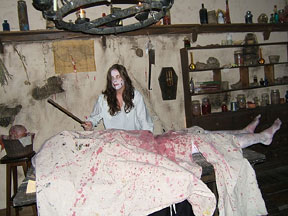
Fun in the Dungeon
Next stop was the Tower of London. There are many legends about whom and what are buried on the grounds. Supposedly the White Tower was built over the grave of a cat to ward off rats, mice, ghosts and witches, but so far it doesn't work. Some of the famous ghosts are Anne Boleyn, Thomas Beckett and the two young princes who were reputedly murdered here. At the Tower, the group spread out. Some of us were treated to a reenactment of the theft of the Crown Jewels by Thomas Blood. We also saw the Martin Tower (where the Jewels were previously kept prior to the theft), the Jewel House (where they are now), The White Tower (containing the Royal Armoury and the Line of Kings), and the Bloody Tower (where the Princes were murdered). There were no sightings of Boris Karloff or Basil Rathbone (a reference to the "Tower of London" film), but we did enjoy watch the guards and the ravens. This stop was both entertaining and educational.
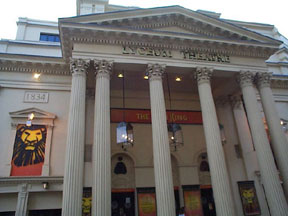
Lyceum Theatre
After the Tower, we traveled by tube to go to the Fortune Theater to see the "Woman in Black." On the way to the show we walked by the Lyceum Theater. This theater has only been reopened for a few years, after being largely unoccupied since 1939, with a brief time as a ballroom. The Lyceum was the early employment of Bram Stoker and was the location for the initial public reading of the story that would become "Dracula." It was also used, from time to time, for meetings of the Golden Dawn. We had dinner before the show. A few of us chose to go to the Opera Tavern. Good food and the chance to see the ghost of Robert Baddley, an actor who died in 1794, were the main offerings from this pub. The "Woman in Black" play was perfect for our group, a ghost story with a great plot, some true scares and a few laughs (nervous laughter?). We talked about the production on the way back.
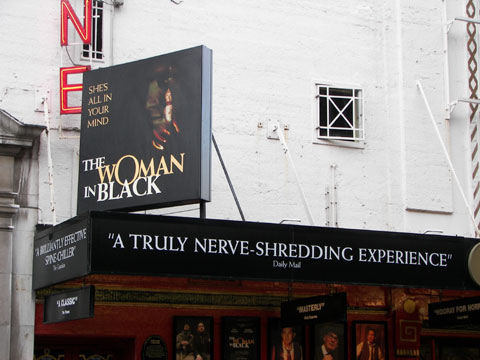
Woman in Black
After the show, we waited to go on a London ghost walk or the Jack the Ripper walk, but the guide never showed up. The time was not wasted, however, as we were entertained by Ed's tales of his prior visits to London. We returned to the hotel by Tube to King's Cross station. Some of us went to the rail section of the station to see the "Harry Potter" platform before returning to the hotel.
Our next day started bright and early with a coach trip to the site of the Borley Rectory, reputed to be one of the world's most haunted places, as well as one of the most famous.
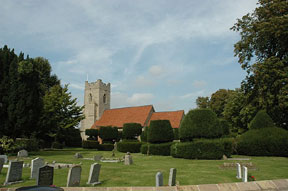
Borley Rectory
The house actually burned down several years ago, but we were able to go to the church, home to some of the tales of hauntings. The hauntings include a ghostly monk, a nun, a coach and many others. Bones, a human jaw and skull, which are thought to be the remains of Marie Lairre, the ghostly nun, were found in the Rectory in 1943.
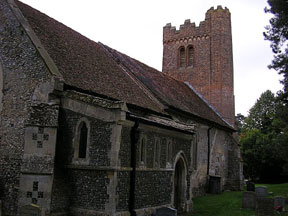
The Haunted Side of Borley
The church was locked, but we were able to see bits of the inside by looking in windows and keyholes. Many people experienced distinct feelings near some of the graves and some people were moved to leave flowers or stones as gifts. I wish there had been an opportunity to enter the church, but the entire area is fiercely guarded by the residents. We did see the old entrance to the vault, sealed for years. It was last opened in the 1920's. There are sometimes odd noises heard from the vault and sudden temperature drops above and near the vault, but these are scientifically explained away by "shifting" and "flooding." We did get to see some very unique and memorable gravestones.
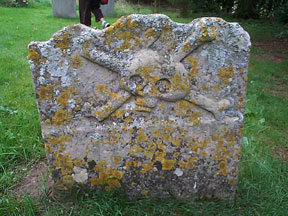
Cool Headstone @ Borley
After Borley we went to Liston. The arrival of our bus almost doubled the population of the village. We toured the haunted church and tower, a surprise additional to our itinerary thanks to our guide Alan. Liston is also the site where the bones of Marie Lairre were reburied in 1945. Her grave is located on the north side of the church, and many people stopped to look for her. A few reported a cold spot near where she is said to be, though the grave itself is unmarked. Some people again reported odd feelings, misty figures and "shadows." Others spent time climbing the tower, not an easy feat.
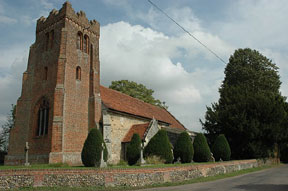
Lyston Church
We returned to the bus to go to the Mill Hotel. The Mill Hotel is located in Sudbury and stands over the river that once fed the powerful mill wheel that can be seen behind glass in the restaurant. When the building was still a mill, a lady and child were said to have drowned beneath the wheel. Their ghosts have been seen in the older parts of the hotel and late at night near the wheel in the restaurant. The most famous feature of the hotel is the grave of a cat in the lobby. Most of us looked, though some did not. Encased in glass can be found the mummified remains of the cat. It was initially buried to bring good luck to the original mill, and was said to ward off ghosts, witches, and other supernatural problems. It was rediscovered in 1971. In 1999 the cat was removed, and bad luck was soon to follow. Within a few weeks after its removal the road outside the hotel exploded, the office flooded several times, and the person who removed the cat had an accident. Things returned to normal when the cat was returned. It has not been removed since.
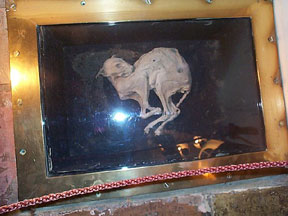
Mummified Cat
We enjoyed a relaxed, pleasant meal at the Mill Hotel, and then drove to Nottingham Castle and the pub named Ye Olde Trip to Jerusalem. On the way we drove through the town of Bury St. Edmunds. It is named after Edmund the Martyr, who was a king of East Anglia. Bury St. Edmunds is most famous for its abbey, which was once a magnificent abbey, but is now in ruins. It is said that, under a full moon, ghostly monks walk through the ruins. The Abbey Church is also famous for being the meeting place of the English barons in 1214 where they agreed to force King John to accept the Magna Carta.
Nottingham Castle, known to most from the legend of Robin Hood, is a large mansion on the site of the former medieval castle. Some of the older structures remain in the cellars and the rock cut tunnels. One ghost that inhabits Nottingham Castle is Sir Roger Mortimer, alleged lover of Queen Isabella. It is his ghostly appearance in one of the tunnels under the castle that gives it the name "Moritmer's Hole." Another spirit seen here is Queen Isabella, who appears as a staring white lady. There is also said to be the shade of a Countess, but no accurate description is made, since those who see her, die. It is said that there are several other presences, and eerie cries heard around the castle area. These are reputed to belong to 28 young sons of Welsh families who were executed there in 1212 A.D. We learned that Nottingham had been the second most violent city in Britain.
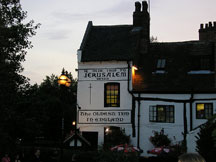
Oldest Inn in England
Ye Olde Trip to Jerusalem is the oldest pub in England, and is built into the rock under Nottingham Castle. It has been an active pub since it's founding in 1189. The pub acquired its name during the year of the ascension to the throne of King Richard the First, known as Richard the Lionheart. One of his first acts was to begin a Crusade to the Holy Land. Knights and men at arms who rallied to his call gathered at Nottingham Castle. They also stopped off at the Inn at the foot of the Castle Rock for refreshments for the road. This was often their last moment of rest on the journey. Each room in the pub is believed to be haunted, and each has a history, and several of them have items of significance. The most famous item, and the centerpiece of the Rock Lounge, is the "Cursed Galleon." Legend has it that the galleon was presented to the Inn by a departing sailor. The galleon is cursed - Legend has it that the last three people who cleaned it died mysterious deaths. Now the galleon is kept in a glass case over the bar, and covered in at least 50 years of dust and cobwebs, but safe from people who might try to clean it. This did not keep members of our macabre group from asking if they could, however. It seems that many pubs in this area have cursed items, and strict rules on who may or may not touch, rub, clean or otherwise deal with the objects. It would probably be possible to do a cursed items pub-crawl. A more tempting item may have been the fertility chair, which gave the promise of future babies to those who sat on it (editor's query: did the author of this tour report, who had a baby nine months later, happen to have taken a seat here?!?).
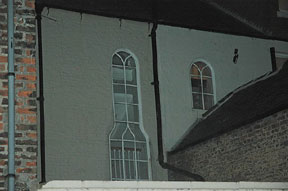
Mysterious Figure
Pictured above - just one of many interesting photos captured on the tour.
Note the mysterious figure (ghost?) in the window on the right
During dinner, we were informed that Rick's birthday was that evening, and so began an impromptu birthday party! After dinner and drinks at the Inn, we headed off for Lincoln for a ghost walk. We left late, however, since a few people had left the pub to walk around Nottingham. Somehow, they found a Hard Rock Café. It's rather funny, since Nottingham looks so medieval that it is hard to imagine a Hard Rock Café there, but there really is one!
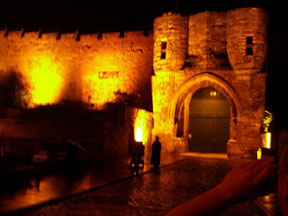
Lincoln Castle
Though it was late, we carried on to Lincoln for a midnight ghost walk. On the way, Alan told us some of his scariest and most unusual stories and gave us the chance to do the same. Our first stop in Lincoln was the cathedral, a beautiful sight at night. We didn't linger, however, as it was starting to rain and we had to get to the castle to begin our walk. Our guide for the evening was Margaret Green, who is famous for her knowledge of Lincoln and surrounding areas, their history and ghosts. Margaret has had her share of encounters and was happy to share them with us. A medium named Yvette accompanied us as well. There were so many ghostly tales just within the first couple of blocks. The first was of a ghostly horse galloping up to the castle, and his equally ghostly rider calling out "open in the name of the King!" Legend has it that it is the ghost of a man (and his horse) who arrived too late to deliver a pardon to his friend who was executed at the castle, and is now stuck perpetually trying to complete his errand.
The next tale was of a little pie shop that used to be a lodging house and is still the original medieval structure. Silly things would happen and were often attributed to the ghost -- a boy named "Humphrey." The man who ran it used to greet Humphrey each day. One day when he did not, the door slammed shut and a knife stuck in the floor and the owner was struck by an unseen hand. Once, a customer also said that staff children should not be permitted to be among the customers. There were no children in the shop that day.
The White Hart Hotel is also very haunted. Due to the late hour we were not able to explore, but we were told of its many eerie tales. The staff admits to five ghosts, but there are probably closer to twelve. One ghost centers his activity on a ginger jar. There is also the "sad room" where there is an oppressive presence that upsets almost anyone who visits the room.
It was in the gate area of Lincoln, near the cathedral, where people would buy "pilgrim badges" from shops in the gateway itself. These badges were usually molded from lead and were worn to show that the individual had visited a shrine or special site. To have many of these showed both your devotion and your status, indicating that you could make such travels. In the gate between the castle and the cathedral is a sculpted face with only two teeth. It is said that to look at him makes you happy. He is a welcoming figure to many children who come to Lincoln.
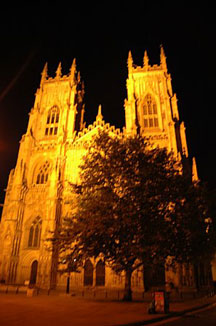
Lincoln Cathedral
Well past midnight and raining significantly, we visited the cathedral. Lincoln Cathedral was built in 1072 and then rebuilt in the 1100's after a fire. It is a huge structure, and decorated all over with both Pagan and Christian images. Some of these images were scary, some sexual, and people were surprised that these would be on a church. It was not uncommon for churches of that era to have such images. Since many people of the time could not read, it was necessary to have vivid and memorable images to remind people about the church's teachings.
Lincoln Cathedral is haunted by monks and other spirits. Margaret informed us that within the past year workers had found a stone coffin in the side yard of the cathedral.
Other than the ghosts that one would expect, she told us of some of the most interesting. One of the most intriguing is not just a single ghost, but many. There was a "plague pit" near the cathedral, and on nights of large Christian ceremonies, the ghosts of the unfortunate souls in the plague pit rise, proceed through the "judgment door" and sing in the church at night. Another more recent ghost is a white lady that began appearing in the cathedral in the 1940's. It is believed that she is the ghost of "Constance," a woman who fell from the tower in the early 40's. We were told of her just as we stood in front of the location where she fell. There is also a strange light that is attributed to her.
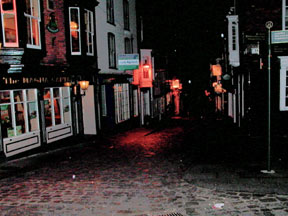
Lincoln Street
The next stop in Lincoln was the Greestone Steps and Postern Gate. In this region people have seen a small clerical figure and other shadows and have felt tugs at their clothing when no one else was present. Additionally, Margaret told us about a ghostly head that is said to have rolled down the steps. We saw a few cats that seemed to disappear if you turned away for the slightest moment. Later I was informed that there are also ghost cats in that area, but the ones I saw seemed very alive. We returned to our hotel at about 1:00 am, totally exhausted but excited for the next day.
Getting a later start the next day, we headed for York, home of the famous York Minster. We toured the Minster together as a group in the morning. The Minster is beautiful and is built upon several layers of history. We began with a tour of the Undercroft. This tour showed the layers of history, beginning with a Roman fortress, followed by a Saxon church and cemetery, a Norman cathedral (built around 1080-1100AD) and then the present Minster (construction began in 13th century). The Roman portions were remnants from the era of Constantine. Some of the Norman structures can also be seen. There was a 13th century well that had been outside the Norman nave. It is now used as a wishing well and a few of us tossed in coins. Apparently no one is sure where the Saxon church was exactly, so it is possible that the well was there from the Saxon times as well. To enter the Minster and know that very little has changed in centuries was somewhat overwhelming.
We also toured the York Minster's Treasury and crypt. The most interesting item in the crypt is the Doomstone. It's from the original Norman church. It shows, at the bottom, flames and cauldrons, and at the top, evil people being forced down. This freestanding sculpture was designed to be a graphic reminder to people of potential consequences of their actions in life. We were not allowed to take any pictures in this area.
The upper levels of the church are beautiful as well, and we heard the tales of two ghosts that are said to reside there. The first is an elderly man who attends services there, and will disappear if people try to speak to him. The second is a figure in medieval clothes who is seen carving wood. He seems to be a craftsman still diligently building the church.
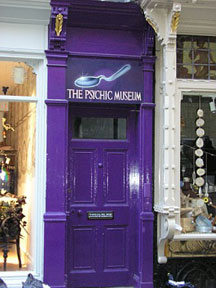
Psychic Museum
Leaving the Minster, we headed to another surprise addition to our itinerary, the Psychic Museum, located in a building known as "The Sign of the Bible." Behind the small purple door we had the opportunity to examine Egely Wheels (an exercise in telekinesis) and other tools to examine psychic capacity. Additionally, we had our aura photos taken. This location is also supposedly haunted, though we were unable to coax the tale out of our guide. All we were told was that we could not go all the way upstairs because "the building is not completely safe up there and the ghost..." She would not elaborate on the ghost. This would be a wonderful place to return and follow up with (as we had limited time), but unfortunately we were one of the last groups that would enjoy it. The museum has subsequently closed, though the building may house a new Ghost Night experience. Some of us stopped into a very cool pub nearby, the Vudu Lounge, for a meal.
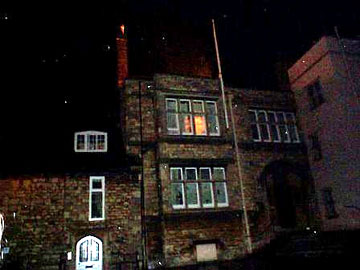
Another mysterious figure in the window
Pictured above - another of the many interesting photos captured on the tour.
Note the mysterious figure (ghost?) and bright orange lights in center window of this abandoned building
After dinner, we continued on to the York ghost walk. The first stop on the walk is known as King's Manor. The ghost of King's Manor is said to be Thomas Wentworth. He was the head of the Northern Council, which met there. He was executed for treason for putting up his own, rather than the king's coat of arms. A portrait of Wentworth is in the City Gallery, across Exhibition Square from King's Manor. The first noted sighting was by a 14-year-old cleaning girl about 80 years ago. She was cleaning the steps and she saw him walk by her. When he passed near her, he was icy cold. He proceeded out the front door, down the path, and then disappeared. Also, a few years ago, on a school tour, a teacher felt a hand on her shoulder on the steps. She turned and saw no one, and then she screamed and scared all the children.
Our next stop was to be the Minster but we took a side jaunt to St. Michael Le Belfrey. This was the baptismal site of Guy Fawkes. We surprised the guide, Lee, by knowing whom Guy Fawkes was as well as being able to relate him to history. So, how many of us watched "V for Vendetta" over and over?
We then continued on to the outside of the Minster, where we again heard the tales of the ghosts of the elderly man and the woodworker. We also heard of the various fires that have struck the Minster. The first major fire of the "modern" Minster was set by a man who claimed to hear voices, which instructed him to set the fire. The second was an accident. The third was 22 years ago, and was started when lightning hit the South Transept. We also heard of a third ghost, though this is not one that would likely be seen by any one now. Near the end of World War II, a girl wandered away from her tour group in the Minster. She was looking at statues. A sailor stepped out from behind a statue, whispered to the girl, and she fainted. When she was revived, she initially lied to her father about the identity of the sailor. Later, she revealed that it had been her brother, and that he had told her that there was a future after death. She soon discovered that he had died at sea.
Shortly before the telling of this tale, it began to rain significantly. This just made it all the creepier to hear of the lost sailor. Later we found out that there had been a severe tornado in Leeds, and that we were getting the overflow weather.
Our next stop was the Treasurer's House. It was built on the former site of the 9th Hispana (Roman Legion) barracks. This is the site of one of York's most famous ghost tales, that of Harry Martindale. He was a plumber working in the basement of the Treasurer's House when he heard a trumpet sound twice. He attempted to continue working, but turned. Behind him in the cellar, he saw a Roman soldier walk through the wall. This man was followed by many more men, horses, and equipment. The men had leather strap armor, skirts, small round wooden shields, and were carrying short swords and spears. These were the soldiers of the 9th, who had been recalled from the area to Rome and were never seen again. It seems that they never left York after all. Martindale realized that they holes they had dug for the plumbing repair had touched the old Roman road, which had been under the site of the house. Martindale promptly packed up his tools and quit plumbing and heating. As he left, the home's curator asked him if he had seen the Roman troop. Apparently they had been seen several times before. Martindale later went into police work and soon became a well-known public figure, but told very few people about his tale until much later in life. Harry did not need to be timid, however, since this troop was seen outside of the house as well.
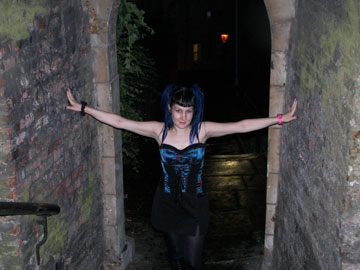
Goth Girl
Our next stop was outside Bedern Hall, previously part of the College of the Vicars. This area became a slum for a long time, but has now been revived into a lovely area. Small children haunt this area. Once there was a "school" there. The children would often be lent out for work. Little boys were often taken by chimney sweeps to be sent up chimneys. This was a scary and dangerous job, and caused the death of many such boys. The children were also often given poor food and accommodations. Disease was rife. George Pimm, the owner of the school, would sometimes hide the bodies of children who died so that he would continue to receive the subsidies for them. He hid at least 13 children over the years. The school itself developed a "strange atmosphere." He started to hear scratches and wailing and other sounds of distress. People in the area have felt tugging on clothing and bags, seen small shadows moving quickly, and I was pinched on the back of my leg when no one was there. We also heard the tale of a woman who was on a tour with her child. She felt a child's hand in hers, thought it was her daughter, looked and saw that it was not. It was a little girl from the school.
Moving on from Bedern Hall, our guide pointed out the sculpted cats in the architecture. These are believed to keep out rats and floods. Thomas Adams, an architect, started the trend and York residents have kept it strong.
Our next stop was the Shambles; it was "butcher's row," previously having over 27 butchers here. The story here was that of Margaret Clitherow, a devout Catholic during the Reformation. She was often imprisoned for her beliefs. She was told that she could avoid a death sentence if she publicly renounced Catholicism. When she refused, she was pressed to death. Later, her hand was cut off and is now preserved as a religious relic. She was canonized Margaret of York in the 1970's. What was believed to be her home, now a shrine, is in the Shambles. Supposedly she haunts it. The irony, however, is that her home is probably not the one that is the shrine, since the street had been renumbered many times since she lived there. Her home is believed to be at what is #10 now, rather than the site of the shrine. We ended the evening with a pub-crawl at the end of the Shambles, winding up at the Golden Fleece. It is a pub reputedly haunted by 5 ghosts, one being the wife of a former owner. The Golden Fleece is one of the oldest and certainly most haunted pubs. Its disorienting structure gave many of us odd feelings of dread and uneasiness. One person in our group couldn't catch their breath, and had to go outside for air.
We had a short time to explore on our own the next morning before leaving for Whitby. Many of us explored the city walls and castle. Apparently, in the early morning the tops of the city walls are popular with joggers, so it made a tour interesting.
We left late morning for our drive over the moors to Whitby. Those who got up early explored the shops near our hotel. The pawnbrokers store had used samurai swords on display and ancient armor. A used goods market had some rare horror books, old videos and even a Universal Frankenstein poster.
This seaside town is known for its ties to Bram Stoker, and its inspiration for the novel, "Dracula." Whitby, according to Stoker, is the site of Dracula's landing in England, but it has its own paranormal tales as well. The first of these we encountered before even arriving in town. There is alleged to be a hobgoblin named "hob" that changes road signs. We kept looking for signs of his mischief. Part of the drive also passes through the prime British UFO areas.
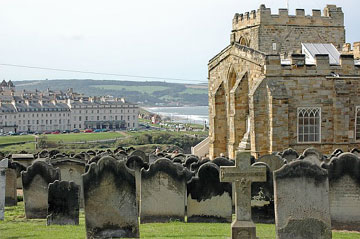
Whitby landscape
Upon arrival in Whitby, we were in awe of the cliffs and the sight of the haunting abbey ruins overlooking the sea. Our first stop in Whitby was the abbey. Most of the group took the 199 steps up to the abbey. Justin and I walked Caedmon's Trod. This walk goes up the other side of the hill, and along the old abbey walls. In the churchyard is a monument called Caedmon's Cross. Caedmon was a bard and a brother in the abbey under the first Abbess, St. Hilda. His poetry is among the best-preserved and earliest examples of Anglo-Saxon poetry. At the abbey, people have seen the ghosts of St. Hilda and other clergy. The church and abbey are beautiful, and we took some wonderful scenic photos there.
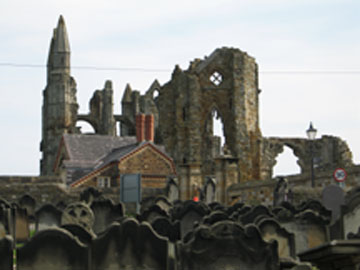
Whitby Abbey
After the abbey, we attended the "Dracula Experience" indoor theme attraction. This is a very commercial, and short, summary of the tale of Dracula, using the Bram Stoker film for its images. It utilizes live actors, lifelike models, electronic special effects and props. It was a muct for our group. We all went through it, and when we exited, we all found ourselves right next to a wonderful gothic shop outside, Gothic Crafts. This was a haven for the shoppers among us, who emerged with many goodies. Robin, picked up a British horror magazine and was pleasantly surprised to find his report of the Dracula Tour in the most current issue. That was a coincidence! Whitby is well known for Jet, also known as black amber. Needless to say, this also appealed to our shoppers, who sought out and procured some lovely jewelry as well.
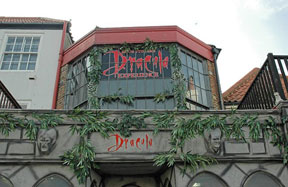
Dracula Experience
Next we walked up to the Royal Hotel for both the Whitby Walk and the Dracula Walk, led by a wonderfully colorful guide, Harry (albeit the color is black!). From the Dracula Walk, we learned about many of the images that Bram Stoker used in his writing. He based many of his landmarks on Whitby, where he often spent his holidays. For example, there is no "The Crescent" in Whitby, but there is a "Royal Crescent Street." Also, the name of the solicitor who arranged for the coffins of earth was a real name of a person Stoker knew from Whitby. Stoker also wove together three local legends. The first is the legend of a black dog, which stems from the Viking times in the area. Stoker includes this image in many places in his work. The next is that of the black coach, drawn by black horses, and driven by Count Dracula himself when Harker arrives in Transylvania. The Whitby legend is of a dead sailor, who was buried in a landlocked grave near the abbey. It is said that his body was reclaimed for the sea by such a ghostly coach. Additionally, Stoker knew a Captain Smalles in Whitby who is reflected in Dracula as Captain Swales. Local legend has it that there was a funeral once, with a horse-drawn hearse, where the wind blew the coffin off the hearse and into the sea. Stoker took this tale and had the Count come in by sea and then carriage. Finally, the most famous tale that Stoker recreated was that of the beaching of the Dmitri, a Russian ship that ran aground some years before Stoker wrote Dracula. This became the basis for the Demeter, the ship upon which Dracula arrived in Whitby.
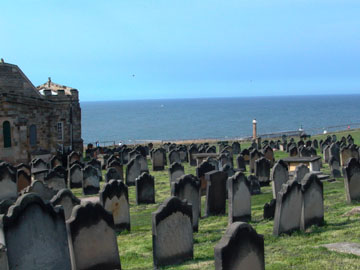
Whiteby graveyard
The black dog legend resurfaced years ago as well when a couple found a big skull when out walking. They brought it home. The wife soon saw a large, scary, fuzzy beast at the window, and heard a heavy knocking. The husband took the skull out side and saw a creature near the water. He threw away the skull and they were no longer bothered by the beast.
After the Dracula Walk we stopped for tea, though we actually ate a full dinner, many of us having worked up a hearty appetite from all the walking so far. We ate traditional fish and chips at a small restaurant in the same building as a former library where Stoker previously sat to write his tales. This building once housed a museum that had the remains of an ichthyosaurus, which was found on the Whitby coast in the 1890's. After dinner we tromped back up the cliffs to the Royal Hotel to begin the Whitby Walk portion of the evening's activities.
The Whitby Walk visited the "screaming tunnel," a replica rail tunnel. Our guide gave us a great amount of history among the many ghostly tales he related throughout the walk. We heard of an architect who hung himself when his business failed. He continues to haunt the dance studio that moved into his home after his death. Elsewhere, near a mounting stone, we heard of a young man who was decapitated by a low branch when his horse bolted. He is sometimes seen and heard as a headless horseman, or simply as a head in the road.
We also heard about the tradition of the "hand of glory," a bizarre relic taken from an executed person, and said to protect burglars. Once, a pub keeper saw an old woman who had a green hand. He shook the hand, and it came off. The burglar fled. The man threw the hand into the fire. Allegedly, it moved itself out of the fire. A girl that worked there mixed some of her blood with milk and poured it over the hand, which disintegrated. The stain of her blood still remains on the floor. Supposedly, in the Town Museum, there is another such hand that was found in the back pew of the Danby Church.
Then there was the story of the Witches of Whitby. There were two sisters, who lived on Penny Farthing Lane. The area was plagued by cats and two men sought to eliminate the cats. The cats were gravely injured, but not killed. The next day, when the sisters did not arrive at work, they were checked on and found to be gravely injured in the same manner as the cats.
Oddly enough, some of the streets have different names on each side of the road. This arose from the offer by a developer to pay for each street, so the local workers were creative and made each road into two or three streets.
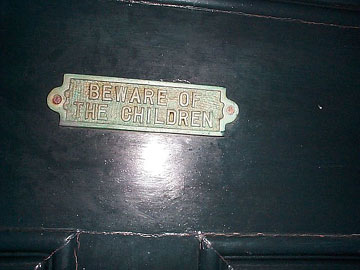
Door in Whitby
Finally, we heard three more stories outside the hotel. There is a lady in gray who is said to be the ghost of a woman who was lifted off the cliff by the wind in her skirts. A young child saw one of the other ghosts in the lighthouse. She saw a body on the stairs in the lighthouse. Her parents didn't. When she described the body to the harbormaster, he told her that her description fit that of the former lighthouse keeper, who had died of heart failure on the spot where she saw him. The third of these is not so much a well-defined ghost, but weird sensations and shadows in the uppermost floor of the Royal Hotel. The army once knocked down a wall there and found an alcove with a body. The Dracula fans among us (all of us, in other words) took photos of the Bram Stoker portrait inside the Royal Hotel.
After this walk, we were tired and eager to reboard the bus, yet reluctant to leave the weird and wonderful Whitby. We loved Whitby! On the coach we were joined by another surprise special guest, authoress Nolene Patricia Dougan, hailed as the new Anne Rice. We were given the opportunity to purchase her vampire novel, "Vrolok," and get her autograph. Vrolok is Slovokian for the word vampire. She also gave us copies of portions of her other works and read excerpts on board. We arrived at the Ibis Hotel in Hull, and most of us fell into a sound sleep. Others paid a visit to the club across the street, appropriately named "Heaven and Hell."
The next morning, we left for Castle Rising Castle, a haunted keep from 1140AD. On the ride there we watched some ghost movies, including "The Haunting of Hill House" and "Skeleton Key." In between films, Alan told us of the Hermitage in Scotland, his personal favorite scary location. We passed towns named New York and Boston on the way, and Witchford Road, which brought us into a discussion of area witches.
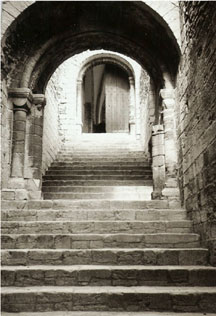
Castle Rising
Castle Rising Castle had been the home and prison of Queen Isabella, and it is she who is said to haunt it most frequently. These most impressive ruins were small, but could have kept us occupied all day. We were told of two teens that snuck into the keep for ghost hunting. They thought they heard children, crept closer, and then fled in terror. Though I don't know if anyone in our group encountered Isabella, we did experience odd misty shapes, cold spots and strange sensations. We took every possible photo opportunity at Castle Rising, and soon were whisked off to Cambridge.
Cambridge is one of England's oldest University cities, founded in the 14th century. There are allegedly over 80 ghosts in Cambridge. The first haunted location we saw was the Rainbow Café, perhaps Britain's only haunted vegetarian restaurant. It is haunted by Sadie Barnett, who died about 15 years ago. She was a landlord for many of the college students and is fondly remembered. She has been seen in the past few years, and there are recent reports of footsteps. The next stop was King's Lane for the story of the Lady in Black, the former wife of a professor. She was killed by a male student with whom she was said to be "friendly." Another home near there has had a ghostly portrait. A woman who examined the home to purchase it saw a painting of a woman in green with a horrid expression. The homeowners told her that there was a ghost in a green dress, but that they knew nothing of a painting. Was this one of the few rare cases of a phantom picture? #4 Trumpington Lane gives us the ghost of a staring woman. In 1899, the owners remodeled the hearth and found three heads. Since this discovery, it has been quiet. Our next stop was behind Peterhouse College, the oldest college here, founded in 1284. The gate in this location was the site of reports of a man, dark and scary, crouching on top of it and looking over the old graveyard. Priests actually exorcized this gate, but the figure continues to be seen from time to time.
We saw yet another haunted church, and heard the tale of St. Mark's eve. It is said that if you sit in the church door of an old church on that night, you will see the ghosts of all the people who will die or be ill from the parish. Those who go in and stay will die, the others who come out will be ill, but recover. The worst sight would be to see yourself in that parade. Across the street from the church where we heard the St. Mark's eve tale, there is a photo store that is haunted by a modern ghost, but the residents only see legs, so they don't know who it is or why it is there.
Then, we heard of several ghosts of Corpus Christi College. One is the ghost of a former Master who hung himself. Another is the ghost of a beau of the Master's daughter. He hid in a closet to avoid her father, and was locked in. She was taken away while he was hidden, and no one found him until he was dead. People now hear bangs, scratching and crashes, as if he is still trying to get out.
On the next street, the Eagle Pub has a ghost who pushes tables to spill drinks. They also have a ghostly Victorian servant girl. They keep an upstairs window open because of the legend of two boys who suffocated in the room. Their lease requires that this window be left open "lest the ghosts return." The Bathhouse pub has a mist upstairs and a ghost that moves barrels. The Red Cow pub has a ghost that appears from the knees up. The tourist information office used to be a library, and is the location for the ghost of Mr. Pink, a former librarian. He has been seen, heard and recognized. A few months prior, while Alan gave the tour to another group, there were strange lights that played around him while he spoke in this area.
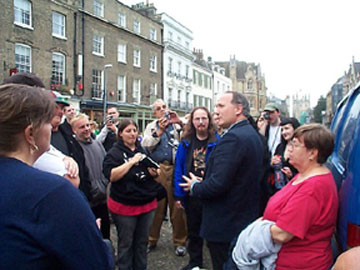
Alan introduces Cambridge
On the next street, we saw the Indigo Coffee House and the Haunted Bookshop. The poltergeist at the Indigo Coffee House took out all the marshmallows and put them on the steps. The Haunted Bookshop had a young female ghost and footsteps on the stairs. There is also the face of a child that looks out the window. She is supposedly the ghost of a girl who died in the cellar.
King's College itself has a ghost on the Chapel roof. This ghost is of a college student who climbed up to put something on the spire (a college prank), but slipped and fell. The chapel crypt also has a white lady. People have also heard horses in the chapel. There are also the screams of Mr. Barrett. He was a prankster who used to jump out of a coffin to scare people. Once people heard him screaming and broke his door in, only to find him dead and staring. His screams still resound from time to time.
Ghost walk over, we returned to the hotel to get ready for the costume party at the Anchor Pub in Cambridge. The Anchor is known not so much for ghosts, but as the location that saw the genesis of Pink Floyd. This was an added plus for the rock n rollers among us!
Our masquerade ball gala event would turn out to be both wonderful and sad, as we realized we would soon head home. We gathered in the lobby of the hotel in full costumes and boarded the bus to return to the Anchor.
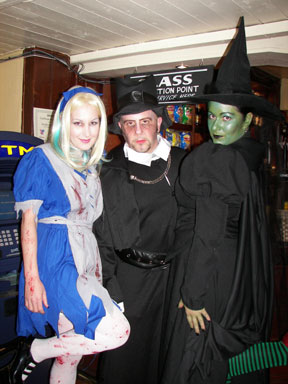
Costume Party
Some people opted to walk or get later transportation so as to surprise the group with their costumes and make-up. Drinks abounded, and the food was good. We gathered in the "Upper Bar," which was actually just a loft over the main bar area. The locals below found us to be quite a sight, though took our presence in stride, and some asked if they might even come up with us.
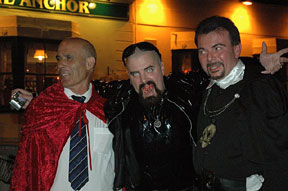
Driver, Scott & Joe @ party
The party ran well into the night, and some people continued to explore Cambridge afterwards, while others reluctantly returned to the hotel to prepare for our return to London and eventually to home.
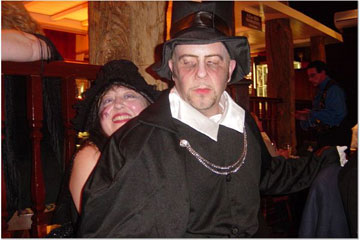
Witchmaster General Charles
On the coach the next morning, we were given prizes for the scariest costume, the sexiest, the best makeup and the best overall. Nobody will ever forget Bob as Shaun of the Dead (Best Overall)! Scariest was Dennis as Charles Manson. Sexiest were Erin and Shannon (tie). The best make-up was Laurie as the very green wicked witch. Also, Lynn took the award for the most shopping, having filled her luggage quota and needing to ship many items home. After the prizes and additional story telling, we arrived in London, where we enjoyed a short historical drive on the way to the airport. We saw the more traditional tourist sights such as Big Ben, Parliament, Westminster Abbey, the new Scotland Yard, the Albert Pub (the oldest in London), the Victoria Palace Theatre, the Wellington Arch, St. Mary's Church and much more.
People maintained their good spirits throughout the ride, but were still sad to know that we would soon be heading our separate ways. We actually left the hotel without two people who would be returning home in their own ways. We left Alan there as well, but he was in his hometown. We waved and called to him as the bus drove away and he walked home in his monk costume from the previous evening. He almost resembled one of the ghostly maniacal monks we had been seeking there.
We arrived at the airport with time to spare, which we spent trading phone numbers, and talking about our experiences. Many of us had experienced some odd sensations, mist, shadow, sound phenomenon, or paranormal experience, some of which were quite dramatic. All in all, it was a very successful tour, as we found what we came for and left with new dear friends as well.
It is necessary to point out that this all would not have been possible without our host Charles and our guide Alan. Thanks to all of you, we will never forget this experience!
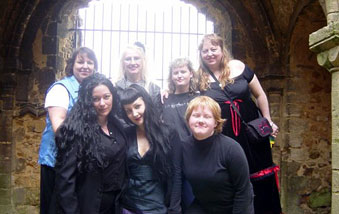 Back to Tour Reports
Back to Tour Reports

Click Here For Free Color Brochure

315 Derby Avenue, Orange, CT 06477 USA
Tel: (203) 795-4737 Fax: (203) 891-8433

TOURSofTERROR@aol.com
















































